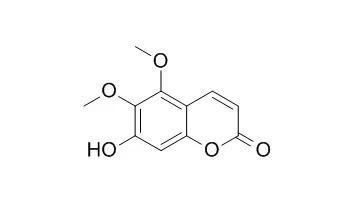| In vitro: |
| Phytotherapy Research 22(6):841-845. | | Antitubercular Activity of Compounds Isolated from Pelargonium sidoides.[Reference: WebLink] | The recent increase in the incidence of tuberculosis with the emergence of multidrug-resistant (MDR) cases has lead to the search for new drugs that are effective against MDR strains of Mycobacterium tuberculosis. and can augment the potential of existing drugs against tuberculosis.
METHODS AND RESULTS:
Pelargonium sidoides. DC (Geraniaceae) is highly valued by traditional healers for its curative properties and is well-known to treat coughs, diarrhea, and tuberculosis. The butanol root extract was found have bioactive inhibitory activity against M. tuberculosis. at a concentration of 2.5 × 103 µg/mL. Phytochemical analysis of the active fraction from the root of P. sidoides. led to the isolation and identification of six compounds: coumarins (Umckalin, scopoletin, 6,8-dihydroxy-5.7-dimethoxy-2H.-benzopyran-2-one, and 6,8-dihydroxy-7-methoxy-2H.-benzopyran-2-one) and flavonoids (catechin and epigallocatechin, which is reported for the first time from P. sidoides.). The isolated compounds were evaluated for antitubercular activity with M. smegmatis. and M. tuberculosis.. Intracellular activity of these compounds was also investigated using THP-1 human macrophages infected with M. tuberculosis..
CONCLUSIONS:
The isolated compounds did not show activity inhibitory against M. tuberculosis., intracellularly and extracellularly, at the highest concentration tested in the current study. Epigallocatechin and scopoletin showed good inhibitory activity against M. smegmatis., exhibiting a minimum inhibitory concentration (MIC) of 7.8 µg/mL. Catechin and Umckalin exhibited MIC values of 31.25 and 62.5 µg/mL, respectively. | | Planta Medica, 1998, 63(6):508-510. | | Antibacterial activity of extracts and constituents of Pelargonium sidoides and Pelargonium reniforme.[Reference: WebLink] |
METHODS AND RESULTS:
The antibacterial activity of extracts and isolated constituents (scopoletin, Umckalin, 5,6,7-trimethoxycoumarin, 6,8-dihydroxy-5,7-dimethoxycoumarin, (+)-catechin, gallic acid and its methyl ester) of Pelargonium sidoides and Pelargonium reniforme (Geraniaceae), plant species used in folk medicine by the Southern African native population, was evaluated against 8 microorganisms, including 3 Gram-positive (Staphylococcus aureus, Streptococcus pneumoniae, and beta-hemolytic Streptococcus 1451) and 5 Gram-negative bacteria (Escherichia coli, Klebsiella pneumoniae, Proteus mirabilis, Pseudomonas aeruginosa, Haemophilus influenzae).
CONCLUSIONS:
Minimum inhibitory concentrations (MICs) varied with the preparation of the extracts and microorganisms tested, from about 0.6 mg/ml for aqueous phases to over 10 mg/ml for crude Pelargonium extracts. With the exception of the ineffective (+)-catechin, all the potentially active compounds exhibited antibacterial activities with MICs of 200-1000 micrograms/ml. The results provide for a rational basis of the traditional use of the titled Pelargonium species. |
|






 Cell. 2018 Jan 11;172(1-2):249-261.e12. doi: 10.1016/j.cell.2017.12.019.IF=36.216(2019)
Cell. 2018 Jan 11;172(1-2):249-261.e12. doi: 10.1016/j.cell.2017.12.019.IF=36.216(2019) Cell Metab. 2020 Mar 3;31(3):534-548.e5. doi: 10.1016/j.cmet.2020.01.002.IF=22.415(2019)
Cell Metab. 2020 Mar 3;31(3):534-548.e5. doi: 10.1016/j.cmet.2020.01.002.IF=22.415(2019) Mol Cell. 2017 Nov 16;68(4):673-685.e6. doi: 10.1016/j.molcel.2017.10.022.IF=14.548(2019)
Mol Cell. 2017 Nov 16;68(4):673-685.e6. doi: 10.1016/j.molcel.2017.10.022.IF=14.548(2019)